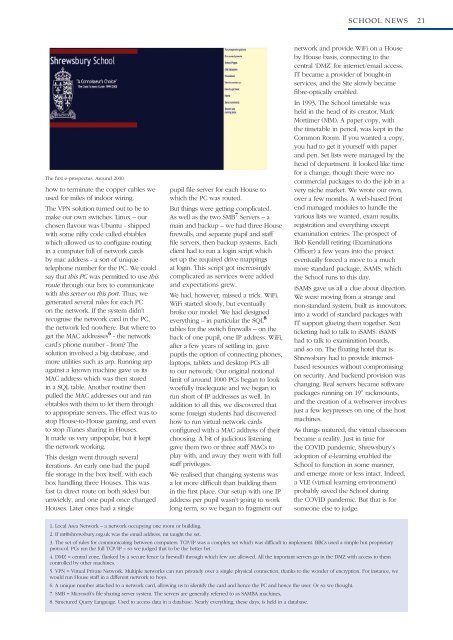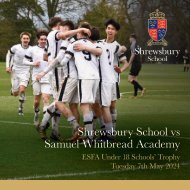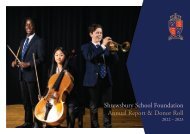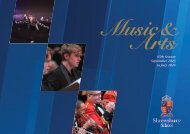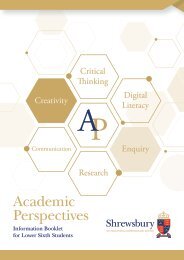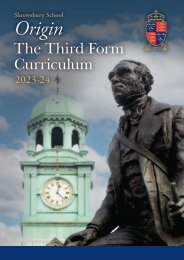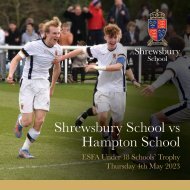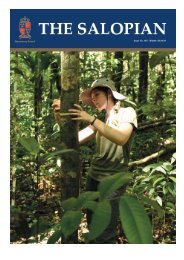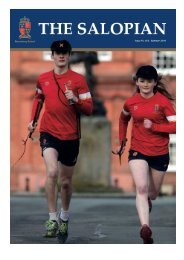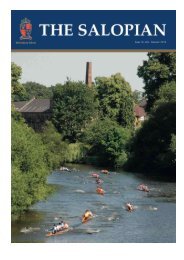The Salopian Summer 2023
v2
v2
Create successful ePaper yourself
Turn your PDF publications into a flip-book with our unique Google optimized e-Paper software.
SCHOOL NEWS 21<br />
<strong>The</strong> first e-prospectus. Around 2000<br />
how to terminate the copper cables we<br />
used for miles of indoor wiring.<br />
<strong>The</strong> VPN solution turned out to be to<br />
make our own switches. Linux – our<br />
chosen flavour was Ubuntu - shipped<br />
with some nifty code called ebtables<br />
which allowed us to configure routing<br />
in a computer full of network cards<br />
by mac address - a sort of unique<br />
telephone number for the PC. We could<br />
say that this PC was permitted to use this<br />
route through our box to communicate<br />
with this server on this port. Thus, we<br />
generated several rules for each PC<br />
on the network. If the system didn’t<br />
recognise the network card in the PC,<br />
the network led nowhere. But where to<br />
get the MAC addresses 6 - the network<br />
card’s phone number - from? <strong>The</strong><br />
solution involved a big database, and<br />
more utilities such as arp. Running arp<br />
against a known machine gave us its<br />
MAC address which was then stored<br />
in a SQL table. Another routine then<br />
pulled the MAC addresses out and ran<br />
ebtables with them to let them through<br />
to appropriate servers. <strong>The</strong> effect was to<br />
stop House-to-House gaming, and even<br />
to stop iTunes sharing in Houses.<br />
It made us very unpopular, but it kept<br />
the network working.<br />
This design went through several<br />
iterations. An early one had the pupil<br />
file storage in the box itself, with each<br />
box handling three Houses. This was<br />
fast (a direct route on both sides) but<br />
unwieldy, and one pupil once changed<br />
Houses. Later ones had a single<br />
pupil file server for each House to<br />
which the PC was routed.<br />
But things were getting complicated.<br />
As well as the two SMB 7 Servers – a<br />
main and backup – we had three House<br />
firewalls, and separate pupil and staff<br />
file servers, then backup systems. Each<br />
client had to run a login script which<br />
set up the required drive mappings<br />
at login. This script got increasingly<br />
complicated as services were added<br />
and expectations grew.<br />
We had, however, missed a trick. WiFi.<br />
WiFi started slowly, but eventually<br />
broke our model. We had designed<br />
everything – in particular the SQL 8<br />
tables for the switch firewalls – on the<br />
back of one pupil, one IP address. WiFi,<br />
after a few years of settling in, gave<br />
pupils the option of connecting phones,<br />
laptops, tablets and desktop PCs all<br />
to our network. Our original notional<br />
limit of around 1000 PCs began to look<br />
woefully inadequate and we began to<br />
run short of IP addresses as well. In<br />
addition to all this, we discovered that<br />
some foreign students had discovered<br />
how to run virtual network cards<br />
configured with a MAC address of their<br />
choosing. A bit of judicious listening<br />
gave them two or three staff MACs to<br />
play with, and away they went with full<br />
staff privileges.<br />
We realised that changing systems was<br />
a lot more difficult than building them<br />
in the first place. Our setup with one IP<br />
address per pupil wasn’t going to work<br />
long term, so we began to fragment our<br />
network and provide WiFi on a House<br />
by House basis, connecting to the<br />
central ‘DMZ’ for internet/email access.<br />
IT became a provider of bought-in<br />
services, and the Site slowly became<br />
fibre-optically enabled.<br />
In 1993, <strong>The</strong> School timetable was<br />
held in the head of its creator, Mark<br />
Mortimer (MM). A paper copy, with<br />
the timetable in pencil, was kept in the<br />
Common Room. If you wanted a copy,<br />
you had to get it yourself with paper<br />
and pen. Set lists were managed by the<br />
head of department. It looked like time<br />
for a change, though there were no<br />
commercial packages to do the job in a<br />
very niche market. We wrote our own,<br />
over a few months. A web-based front<br />
end managed modules to handle the<br />
various lists we wanted, exam results,<br />
registration and everything except<br />
examination entries. <strong>The</strong> prospect of<br />
Bob Kendall retiring (Examinations<br />
Officer) a few years into the project<br />
eventually forced a move to a much<br />
more standard package, iSAMS, which<br />
the School runs to this day.<br />
iSAMS gave us all a clue about direction.<br />
We were moving from a strange and<br />
non-standard system, built as innovators,<br />
into a world of standard packages with<br />
IT support glueing them together. Seat<br />
ticketing had to talk to iSAMS. iSAMS<br />
had to talk to examination boards,<br />
and so on. <strong>The</strong> floating hotel that is<br />
Shrewsbury had to provide internetbased<br />
resources without compromising<br />
on security. And backend provision was<br />
changing. Real servers became software<br />
packages running on 19” rackmounts,<br />
and the creation of a webserver involves<br />
just a few keypresses on one of the host<br />
machines.<br />
As things matured, the virtual classroom<br />
became a reality. Just in time for<br />
the COVID pandemic, Shrewsbury’s<br />
adoption of e-learning enabled the<br />
School to function in some manner,<br />
and emerge more or less intact. Indeed,<br />
a VLE (virtual learning environment)<br />
probably saved the School during<br />
the COVID pandemic. But that is for<br />
someone else to judge.<br />
1. Local Area Network – a network occupying one room or building.<br />
2. If mt@shrewsbury.org.uk was the email address, mt taught the set.<br />
3. <strong>The</strong> set of rules for communicating between computers. TCP/IP was a complex set which was difficult to implement. BBCs used a simple but proprietary<br />
protocol. PCs ran the full TCP/IP – so we judged that to be the better bet.<br />
4. DMZ = central zone, flanked by a secure fence (a firewall) through which few are allowed. All the important servers go in the DMZ with access to them<br />
controlled by other machines.<br />
5. VPN = Virtual Private Network. Multiple networks can run privately over a single physical connection, thanks to the wonder of encryption. For instance, we<br />
would run House staff in a different network to boys.<br />
6. A unique number attached to a network card, allowing us to identify the card and hence the PC and hence the user. Or so we thought.<br />
7. SMB = Microsoft’s file sharing server system. <strong>The</strong> servers are generally referred to as SAMBA machines,<br />
8. Structured Query Language. Used to access data in a database. Nearly everything, these days, is held in a database.


